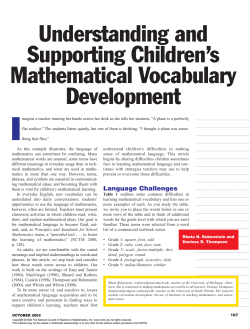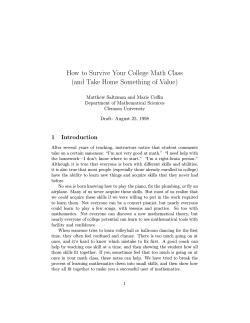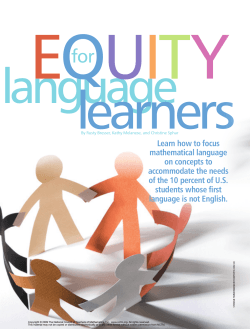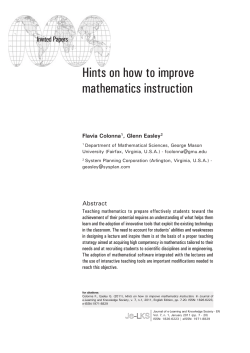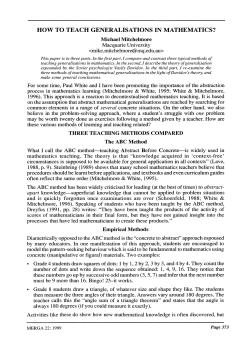
This article was downloaded by: [Simon Fraser University] Publisher: Routledge
This article was downloaded by: [Simon Fraser University] On: 04 February 2013, At: 08:15 Publisher: Routledge Informa Ltd Registered in England and Wales Registered Number: 1072954 Registered office: Mortimer House, 37-41 Mortimer Street, London W1T 3JH, UK Research in Mathematics Education Publication details, including instructions for authors and subscription information: http://www.tandfonline.com/loi/rrme20 Mathematical thinking: how to develop it in the classroom a Rina Zazkis & Dov Zazkis a b Simon Fraser University, Canada b San Diego State University, USA Version of record first published: 04 Feb 2013. To cite this article: Rina Zazkis & Dov Zazkis (2013): Mathematical thinking: how to develop it in the classroom, Research in Mathematics Education, 15:1, 89-95 To link to this article: http://dx.doi.org/10.1080/14794802.2013.763609 PLEASE SCROLL DOWN FOR ARTICLE Full terms and conditions of use: http://www.tandfonline.com/page/terms-andconditions This article may be used for research, teaching, and private study purposes. Any substantial or systematic reproduction, redistribution, reselling, loan, sub-licensing, systematic supply, or distribution in any form to anyone is expressly forbidden. The publisher does not give any warranty express or implied or make any representation that the contents will be complete or accurate or up to date. The accuracy of any instructions, formulae, and drug doses should be independently verified with primary sources. The publisher shall not be liable for any loss, actions, claims, proceedings, demand, or costs or damages whatsoever or howsoever caused arising directly or indirectly in connection with or arising out of the use of this material. Research in Mathematics Education, 2013 Vol. 15, No. 1, 8995 BOOK REVIEW Downloaded by [Simon Fraser University] at 08:15 04 February 2013 Mathematical thinking: how to develop it in the classroom, by Masami Isoda and Shigeo Katagiri, Singapore, World Scientific Publishing Company, 2012, 297 pp., £27 (paperback), ISBN10: 9814350842 Was Polya Japanese? Mathematical thinking: how to develop it in the classroom, by Masami Isoda and Shigeo Katagiri, is the first volume in the series Monographs on Lesson Study for Teaching Mathematics and Sciences. The introductory Chapter 1 explains the pedagogical approach, which is referred to as ‘‘Problem Solving Approach’’. The approach is presented in five phases: Posing the Problem, Planning the Solution, Executing Solutions, Discussion (Validation and Comparison), and Summarization and Further Development. There is a striking resemblance to George Polya’s (1945/1988) description of the four steps of problem solving, which despite numerous extensions and critique (e.g., Schoenfeld 1985; Schoenfeld 1992) is still a major reference in instructional materials for teachers (e.g., NCTM 2000; van der Walle and Folk 2008). A question comes to mind: Was Polya Japanese?1 Or maybe this is simply a case of ‘‘great minds think alike’’? Reading the book we found ourselves making numerous connections to Western education research literature and traditions, as similarities were at times apparent. The book is intended for both teachers and researchers, and consists of two parts. Part I entitled Mathematical thinking: theory of teaching mathematics to develop children who learn mathematics for themselves according to the authors, explains Katagiri’s theory, which is ‘‘the theory for developing mathematical thinking in the classroom.’’ Part II of the book entitled Developing mathematical thinking with number tables: how to teach mathematical thinking from the viewpoint of assessment presents 12 examples of lessons. The two parts are very different in their structure and content. So we comment on each part separately. Part I The first part, according to the authors, explains ‘‘the theory for developing mathematical thinking in the classroom’’ (1), which is also referred to as Katagiri’s theory. In Chapter 2 the authors present a compelling argument for the need for, and importance of, the development of mathematical thinking. They further provide in Chapter 3 a categorization of the components of mathematical thinking, which they name: Mathematical Methods, Mathematical Ideas, and Mathematical Attitudes. Chapters 46 are dedicated to itemizing what each of these entails. 90 Book review There are 11 types of Mathematical Methods that are exemplified and discussed briefly in Chapter 4: inductive thinking, analogical thinking, deductive thinking, integrative thinking, developmental thinking, abstract thinking, simplifying, generalization, specialization, symbolization, and quantification and schematization (the last two are discussed together, just in case a reader counted 12 rather than 11). Take the following example, provided by the authors: Downloaded by [Simon Fraser University] at 08:15 04 February 2013 Consider the statement ‘‘when two numbers are added together, then even if the order of the numbers is reversed, the sum remains the same’’. If the meaning is not clear, try a concrete example, such as 3 and 5. The statement is now ‘‘When 3 and 5 are added together, then even if the order of 3 and 5 is reversed, the sum remains the same’’. In this form, the meaning is easy to see. (72) We invite the reader to predict, what type of mathematical thinking is exemplified here? What type of mathematical thinking can be developed or reinforced in learners with this example? Our immediate reaction is that this example is concerned with specialization, enhancing/interpreting the general with the particular (Mason and Pimm 1984). Further deliberation is that repeated specialization can lead to generalization, that is, understanding of the general case. We also see a connection with symbolization, as the statement can be summarized as abba, or, avoiding letters for beginners, as j j. However, this example is included in the section on ‘‘abstract thinking’’, where the authors comment following this example: ‘‘This type of concretization is important, and since the goal is actually abstraction, it can be included as a type of abstract thinking’’ (72). For us, abstraction of this statement can be achieved only much later, in a form of A 8 B B 8 A, where addition is replaced with an abstract operation, denoted with a 8. Of course, the type of thinking invoked may depend on the goal of the activity, but we wonder whether it would have been beneficial to emphasize the connections between the different types of thinking listed. For example, ‘‘integrative thinking’’ is actually a kind of generalization, what Harel and Tall (1991) conceived as ‘‘reconstructive generalization’’; or specializing and generalizing are ‘‘two sides of the same coin’’, as articulated in the works of Mason and his colleagues (e.g., Mason, Burton, and Stacey 1982/2010; Mason and Johnston-Wilder 2006). There are nine Mathematical Ideas listed and exemplified in Chapter 5: sets, units, representation, operation, algorithms, approximations, fundamental properties, functional thinking (we were intrigued that ‘functional thinking’ was not in the Mathematical Methods list, along with other ways of thinking, or alternatively why it was not referred to in this list as ‘functions’), and expressions. The Mathematical Attitudes considered in Chapter 6 are named: Objectifying, Reasonableness, Clarity and Sophistication. Here, it is important to note that the authors consider attitude as a ‘‘mindset’’, a mathematical disposition, where one examines the obtained answers and seeks ‘‘better’’ ways to describe a situation. This appears to us the main place of dissimilarity with the contemporary literature published in English, in which attitudes are considered in the affective domain and connections are drawn among attitudes, beliefs and values, (e.g., Hannula 2002; McLeod 1992). Chapter 7, which is the last chapter in Part I, offers a list of questions that cultivate mathematical thinking, (some of which offer advice rather than ending with Research in Mathematics Education 91 a question mark). Questions in each phase are identified with A, M, and I, paving a connection to Attitudes, Methods and Ideas, respectively. For example, a question ‘‘Can this be said more accurately?’’ exemplifies an Attitude of Sophistication; a question ‘‘Can this be said in such a way that it also applies to other times?’’ exemplifies a Method of Generalization; an advice to replace numbers with simpler numbers exemplifies a Method of Simplification. Unlike the framework for generating questions exemplified in Watson and Mason (1998) and in Mason (2000), the questions in Chapter 7 are not content specific, and resemble general heuristics that can be used across a wide range of content. Downloaded by [Simon Fraser University] at 08:15 04 February 2013 Part I: reflections The Preface to the book states that it will help teachers ‘‘to teach mathematics in interesting ways’’. Further, for researchers, ‘‘This book provides you with a theory of mathematics education which has been developed with teachers through lesson study . . .’’ (vii). Indeed, teachers will find in the book a variety of interesting tasks, some of which are open-ended and can be extended for students of various abilities. As for ‘‘the theory’’ we suggest, with some hesitation, that we did not find in the book something that can be summarized as ‘‘a theory’’. That is, we cannot answer the question, ‘‘What is Katagiri’s theory?’’, despite the fact that there are many references to such a theory. We are further puzzled by the claim of the distinguished editors of this series, who advise that ‘‘This monograph series provides teachers, educators and researchers with illuminating exemplars of the theoretical advances in teaching mathematics and science that are the outcomes of lesson study’’(vi). It would have been helpful to explain what they consider as an ‘‘illuminating exemplar of the theoretical advances’’. However, it may be inappropriate to judge the series by its first volume only. The reason for such miscommunication and unfulfilled expectations could be in the fact that mathematics education, as a field of study, has not yet reached an agreement on how the multifaceted term ‘‘theory’’ is used in our research (Leikin and Zazkis 2012). A recent (2010) book2 Theories of mathematics education: Seeking new frontiers, edited by Sriraman and English, sharpened a debate on what constitutes a theory of Mathematics Education, (in contrast to a perspective, a framework or a model), and whether the existence of a multitude of theories versus one ‘‘grand theory’’ is preferable, or whether the latter is even possible in the field. Leikin and Zazkis (2012) emphasized that while the debate on desirability of plurality of theories continues, an agreement on what is considered a theory is essential. Our view of what constitutes a theory is influenced by Shoenfeld (2000, 646), who listed eight criteria that theories in mathematics education ought to satisfy: descriptive power, explanatory power, scope, predictive power, rigour and specificity, falsifiability, replicability, and multiple sources of evidence. Under which definition of a theory Part I of this book can be seen as a theory rather than classification/ typification or a pedagogical approach remains for us an open question. Part II As mentioned above, the second part of the book consists of 12 examples of lessons that develop and assess students’ mathematical thinking. It is important to note that 92 Book review Downloaded by [Simon Fraser University] at 08:15 04 February 2013 assessment/evaluation here does not mean grading, but is used to determine what children have learned. All the lessons are based on rectangular arrays of numbers, referred to as number tables: consecutive whole numbers from 0 to 100 or from 0 to 200, listed in 10 columns or in 7 columns, (the latter referred to as ‘‘extended calendar’’), and the 10-column array of odd numbers from 1 to 199. Each lesson is accompanied by a worksheet that lists the tasks to be explored by students. For example, a table with ‘‘extended calendar’’ is shown, in which a ‘‘diagonal arrow’’ is drawn from 1 to 49 (See Fig 1). Figure 1. Extended calendar. Tasks presented to students include the following: 9 1 8 lies on the arrow in the above table. Are there any other pairs of numbers on this arrow that differ by 8? What can you say about this? (We attribute lack of rigour in the phrasing of this and other instructions to improper translation). Additional tasks in this lesson examine numbers on arrows parallel to this one and also arrows drawn in other directions. Children are invited to write down the rules that they find. Of the 12 lessons, six are concerned with the arrangement of numbers on the tables, similar to the example above, two attend to sums of numbers (for example, finding numbers with the sum of 99), two consider squares of numbers on the tables and the relationships among the numbers within the chosen squares, and two deal with the arrangement of multiples and common multiples. Part II: reflections The lesson process for each task is presented in a 3-column table. The first column is devoted to teacher’s activities, where one finds mostly guiding questions associated with each of the tasks. The second column lists expected students’ activities. These two columns remind us of the format of a standard ‘‘lesson plan’’. The third column identifies the kinds of mathematical thinking related to the teacher’s activities/ questions and corresponding evaluation. The evaluation column consists mostly of the instruction ‘‘gather and evaluate each student’s written notes’’. Some lessons also include ideas for further development, which are extensions of the tasks. These extensions at times assume higher levels of mathematical sophistication. A distinctive feature of the presented lessons is ‘‘summarization on the board’’, where we learn that Japanese teachers plan in advance what will be put on the board and how to arrange it, as they are not supposed to erase the board during the lesson. Downloaded by [Simon Fraser University] at 08:15 04 February 2013 Research in Mathematics Education 93 While the lessons present worthwhile tasks for developing mathematical thinking, we were surprised that only slim attention is devoted to argumentation and justification. Indeed, students are expected to notice and describe a variety of patterns, to summarize those as ‘‘rules’’ in their notes, but the explanation of why the observed pattern/rule holds is attended to only in passing, if at all. Further, it may be obvious to Japanese teachers, but it is unclear from what is presented in the book, to what degree the detailed ‘‘teachers’ activities’’ are envisaged as directives to follow or suggestions to consider. One important concern with the ‘‘lesson process’’ presented here echoes the concerns that were voiced in considering the traditional lesson plan (Zazkis, Liljedahl, and Sinclair 2009). That is, the format of ‘‘lesson process’’ or at least what is presented in this format in the 12 examples does not attend to potential errors of students. Indeed, it was acknowledged that for some activities students ‘‘are not sure what to do’’ (164), or ‘‘don’t understand what to do’’ (236). But the lesson write-ups appear to suggest that students will draw expected conclusions after minimal prompting. After years of Japanese research on Lesson Study, we anticipated finding some attention to pitfalls in students’ mathematical thinking and elaboration on how those can be addressed in teaching. A lacuna about the detail of the role of the teacher is, perhaps, apparent in research world-wide. Acknowledging that traditional lesson planning does not consider students’ errors, and that consideration of these is an important element of preparing to teach, a method called a Lesson Play was developed (Zazkis, Liljedahl, and Sinclair 2009; Zazkis, Sinclair, and Liljedahl 2013). Lesson Play is an elaboration on a lesson or part of a lesson, in the form of a script that presents interaction between a teacher and students, and among students, based on a ‘‘prompt’’ that introduces a student error in conclusion or in reasoning. The task is to continue the interaction in an attempt to help the student to face and correct the error. We wonder what a Lesson Play, based on the advocated lesson process, would look like. Conclusion Considering the book as a whole, we find some inconsistency between the claims made in Part I and how practical implementation is envisioned in Part II. For example, the authors claim: In the Problem Solving Approach, the tasks are given by the teachers but the problematics or problems which originate from the tasks for answering and need to be solved are usually expected to be posed by the children’’. (5, our italics) However, in Part II we find no indication of problematics that children are expected to ponder about. Rather, we find successive questions planned by the teachers with respect to predefined tasks and possible prompts in case the expected response from the students does not materialize. This brings us back to the declared objective, which is, to develop children ‘‘who learn mathematics by/for themselves’’ (3). For us, the meaning of ‘‘explore mathematics by/for themselves’’ (4, our italics) remains unclear. There is, perhaps, a shared understanding of how a teacher in Japan works with student responses that was not made explicit. 94 Book review It was interesting to witness how analogous ideas have developed in different parts of the world and in different educational settings. It is a worthwhile effort to introduce the culture of Japanese teachers and Japanese teaching to English speaking/English reading audiences. However, for an audience familiar with the works of Polya, Schoenfeld, and Mason and colleagues, we are left to ponder, what does one learn from this book about mathematical thinking as a construct, or about children’s mathematical thinking in particular? Downloaded by [Simon Fraser University] at 08:15 04 February 2013 Notes 1. This is our attempt to echo the question ‘‘Was Pythagoras Chinese?’’(Kao and Swetz. 1977). 2. This was reviewed by Miche`le Artigue in Research in Mathematics Education Vol. 13, No. 3 (2011). References Artigue, M. 2011. Review of ‘‘Theories of mathematics education: Seeking new frontiers’’. Research in Mathematics Education 13: 3116. Hannula, M.S. 2002. Attitude towards mathematics: Emotions, expectations and values. Educational Studies in Mathematics 49: 2546. Harel, G., and D. Tall. 1991. The general, the abstract and the generic in advanced mathematics. For the Learning of Mathematics 11, no. 1: 3842. Kao, T.I., and F.J. Swetz. 1977. Was Pythagoras Chinese?: An examination of right triangle theory in Ancient China. Philedelphia, PA: Pennsylvania State University Press. Leikin, R., and R. Zazkis. 2012. On the connections between general education theories and theories in mathematics education. Review of Sriraman B., and L. English, eds. 2010. Theories of mathematics education: Seeking new frontiers. Journal for Research in Mathematics Education 43, no. 2: 22332. Mason, J. 2000. Asking mathematical questions mathematically. International Journal of Mathematics Education in Science and Technology 31, no. 1: 97111. Mason, J., L. Burton, and K. Stacey. 1982/2010. Thinking mathematically. London: AddisonWesley. Mason J., and S. Johnston-Wilder. 2006. Designing and using mathematical tasks. Diss, Tarquin Publications. Mason, J., and D. Pimm. 1984. Generic examples: Seeing the general in the particular. Educational Studies in Mathematics 15: 27789. McLeod, D.B. 1992. Research on affect in mathematics education: A reconceptualization. In Handbook of research on mathematics teaching and learning, ed. D.A. Grouws, 57596. New York: Macmillan. National Council of Teachers of Mathematics (NCTM). 2000. Principles and Standards for School Mathematics. Reston, VA: NCTM. Po´ lya`, G. 1945/1988. How to solve it: A new aspect of mathematical method. Princeton, NJ: Princeton University Press. Schoenfeld, A. 1985. Mathematical problem solving. New York, NY: Academic Press. Schoenfeld, A. 1992. Learning to think mathematically: Problem solving, metacognition, and sense-making in mathematics. In Handbook for research on mathematics teaching and learning, ed. D.A. Grouws, 33470. New York: Macmillan. Schoenfeld, A. 2000. Purposes and methods of research in mathematics education. Notices of the American Mathematical Society 47: 6419. Van de Walle, J. A., and S. Folk. 2008. Elementary and middle school mathematics: Teaching developmentally, 2nd Canadian ed. Toronto, ON: Pearson Canada. Research in Mathematics Education 95 Watson, A., and J. Mason. 1998. Questions and prompts for mathematical thinking. Derby: Association of Teachers of Mathematics. Zazkis, R., P. Liljedahl, and N. Sinclair. 2009. Lesson plays: Planning teaching vs. teaching planning. For the Learning of Mathematics 29, no. 1: 407. Zazkis, R., N. Sinclair, and P. Liljedahl. 2013. Lesson Play in mathematics education: A tool for research and professional development. New York, NY: Springer. Downloaded by [Simon Fraser University] at 08:15 04 February 2013 Rina Zazkis Simon Fraser University, Canada Email: zazkis@sfu.ca Dov Zazkis San Diego State University, USA # 2013, Rina Zazkis and Dov Zazkis http://dx.doi.org/10.1080/14794802.2013.763609
© Copyright 2025





